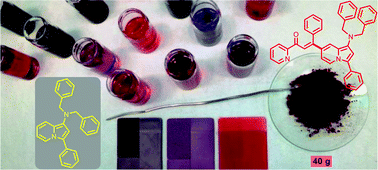Metal-free remote-site C–H alkenylation: regio- and diastereoselective synthesis of solvatochromic dyes†‡
Abstract
Lately, transition-metal catalysed C–H alkenylation of nitrogen heterocycles has gained increasing attention, often with the intervention of complex and expensive catalytic systems. On the other hand, both, chalcones and indolizines are versatile families of compounds with applications in diverse research areas, including materials science, because of their prominent photophysical attributes. We set forth herein the metal-free regio- and diastereoselective C–H alkenylation of indolizines through a very simple and mild acid–base approach. The most fascinating fact in this remote-site Csp2–Csp2 bond formation is that only one starting material is utilised, which undergoes a formal self-alkenylation to integrate a chalcone moiety and furnish a new family of dyes; a plausible reaction mechanism has been put forward. A one-pot multicomponent protocol was conceived that generates the starting indolizine in situ and has been extended to a multi-gram scale synthesis with equal efficiency. The dyes show a single structure in the solid state but two stable structures in solution (rotamers). Preliminary studies on the optical properties of the dyes reveal a particle-size dependent colour in the solid state and solvatochromism (i.e., different colours in solution depending on the solvent polarity). Remarkably, the solvatochromic behaviour was also displayed in plastics. We believe that this finding opens new avenues in the fields of heterocyclic chemistry, dyes, and materials science.



 Please wait while we load your content...
Please wait while we load your content...